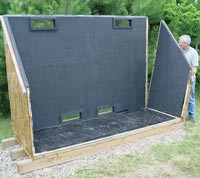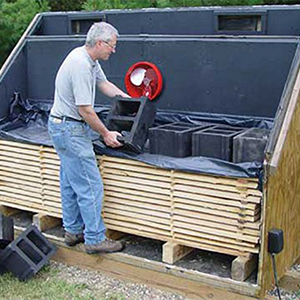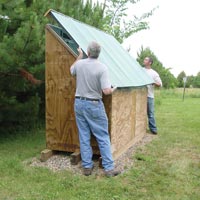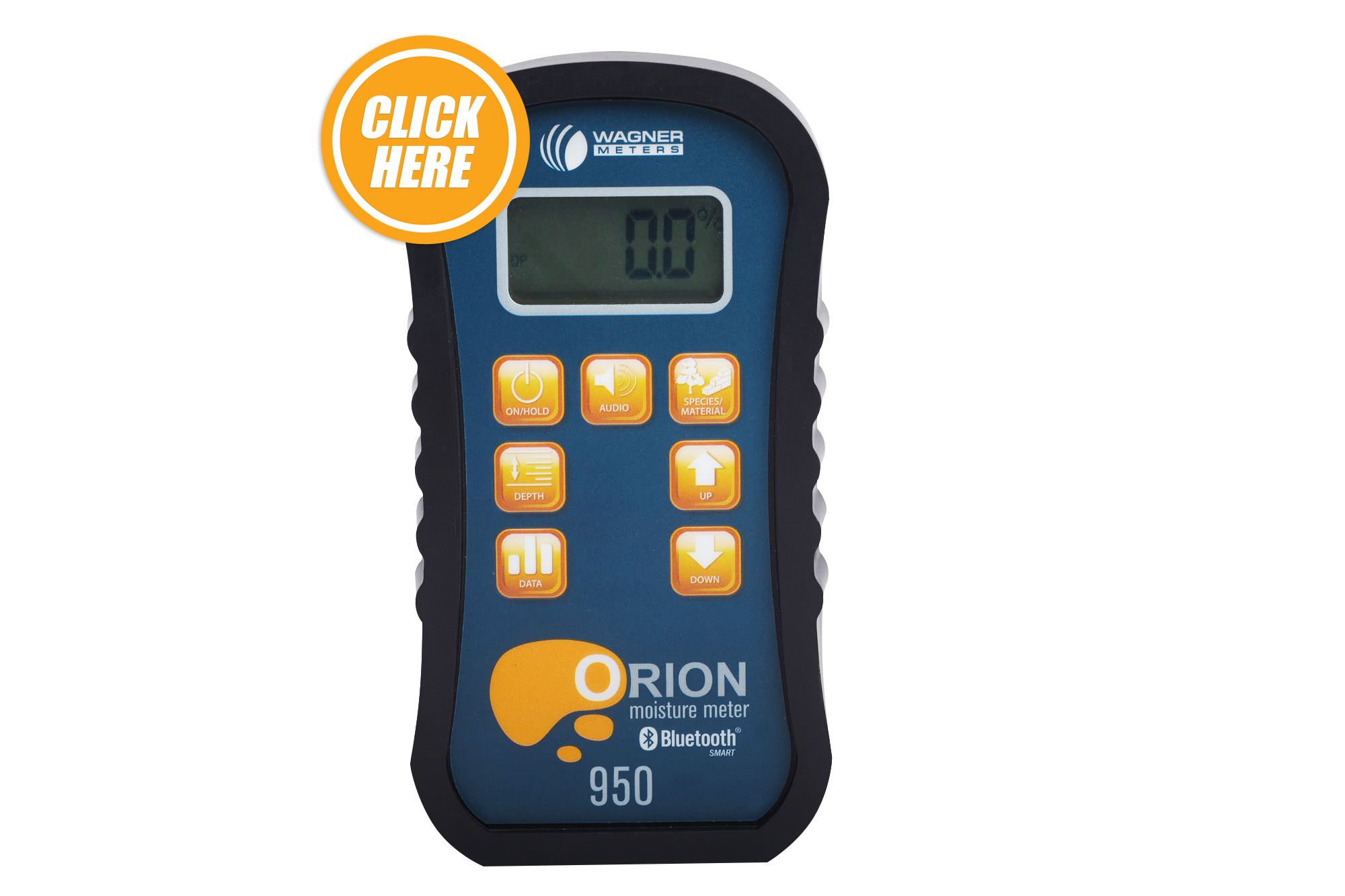Solar Dried Lumber Moisture Concerns – Solar Kiln
As a woodworker or sawmill operator, you know that properly dried wood is essential for producing high-quality, durable projects.
Solar kilns offer an affordable and eco-friendly alternative to traditional drying methods, helping to accelerate the drying process while reducing energy costs. But with these benefits come moisture challenges that can impact the integrity of your wood if not properly managed.
Understanding how to monitor and control moisture levels in solar-dried lumber is key to preventing warping, cracking, and shrinkage—all of which can ruin a project before it even begins. In this guide, we’ll explore:
✅ The advantages of using a solar kiln
✅ Key design features for efficient drying
✅ How long it takes to properly dry wood
✅ The importance of moisture meters in preventing defects
✅ The ideal moisture content for different woodworking applications
Whether you’re building your own solar kiln or simply looking to optimize your drying process, this article will help you master moisture control and ensure that your wood remains stable and ready for use.
Solar kilns are gaining popularity among hobbyists and professional woodworkers seeking to dry their own lumber. With the high cost of dried wood at lumberyards, solar kilns offer an economical, eco-friendly alternative to air-drying, which can take months and result in warped or cracked wood.
Table of Contents
- The Advantages of Solar Kilns
- Understanding Key Solar Kiln Design Features
- Are Solar Kilns Worth It?
- How Long Does it Take to Dry Wood in a Solar Kiln?
- Monitoring Moisture Levels in Solar-Dried Lumber
- Moisture Meters
- Optimal Moisture Content Levels for Various Applications
- The Benefits of Solar Kilns for Woodworkers
Greenwood, on the other hand, costs much less. However, air-drying lumber can take several months, leading to warping and cracking before it can be used. Drying wood in a controlled environment requires much less time and allows the wood to contract without warping.
The Advantages of Solar Kilns
A solar kiln dries green wood quickly and safely, minimizing defects and generating zero CO² emissions. This makes them an environmentally responsible choice for wood drying. Dr. Eugene Wengert, an extension forest products specialist at the University of Wisconsin-Madison, highlights their ease of use: simply load the wood, adjust the vents, and monitor the moisture content (MC) near the end of the drying process.
Solar-drying kilns are the simplest, cheapest, and safest way to dry green wood quickly, and they are good for the environment since they don’t generate CO² emissions. A solar kiln will dry the wood with a smaller chance of defects than air drying.

“And they won’t dry wood too fast,” says Dr. Eugene Wengert, an extension forest products specialist at the University of Wisconsin-Madison. “It’s pretty much a ‘set it and forget it’ system. You can just put the wood in there and almost forget it. It’s only near the end of the drying when you need to measure moisture content (MC) to determine if it’s time to stop the process and pull the wood out.”
Understanding Key Solar Kiln Design Features
Dr. Wengert developed a popular and simple solar kiln design in 1978. It is often referred to as the Virginia Tech Solar Kiln because Dr. Wengert developed it while working at Virginia Tech. Although there are different solar designs today, the Virginia Tech design is the kiln model considered the standard by which other kilns are built. Woodworkers can find instructions for this model and other similar designs online.
Are Solar Kilns Worth It?
The initial investment for a solar kiln depends on its size and building materials, but it typically pays for itself in the long run. Solar kilns come in various sizes, with small kilns drying 800-1,000 board feet and large kilns drying 1,500-2,000 or more board feet.
How Long Does it Take to Dry Wood in a Solar Kiln?
Drying wood in a solar kiln, like the Virginia Tech model, takes approximately one month in moderately sunny conditions in the mid-latitudes of the United States. The kiln absorbs sunlight through transparent glazing and heating the black-painted interior surfaces. Factors such as the size of the kiln, solar panel area, and roof angle play critical roles in the drying process.
Circulating air through the stack of wood requires an electric fan, and larger kilns may need multiple fans for optimal airflow.

As air is heated in the collector space, one or more fans circulate it through the lumber, enabling it to absorb moisture from the lumber’s surface. When the evaporated moisture increases the relative humidity to where it gets too high in the chamber, it releases it through vents in the back of the kiln.
To alter the size of a kiln, one needs to keep in mind an important ratio: For every ten board feet of capacity, one square foot of solar panel or roof area is needed. If the kiln has too much solar panel area, one risks the wood drying too fast, causing the wood to check and split.
However, if there’s not enough solar panel area, there’s the risk of never being able to dry the wood below 15% MC.
In order to circulate air through the stack of wood, it’s necessary to install an electric fan. If a larger kiln is built, two or more fans will be needed for optimum airflow.
Roof angle also is important. To figure out the proper angle, one needs to determine the latitude of the kiln. The latitude number is used for the pitch of the kiln roof.
For example, in Minnesota, the latitude is about 45 degrees north. In that case, the solar panel would be mounted at a 45-degree angle facing south. If used during winter, the angle should be increased by 10 degrees (in this case, to 55 degrees) since the sun’s angle changes from summer to winter.
Interested in building a solar kiln?
Review the following magazine article about building a solar kiln.
Monitoring Moisture Levels in Solar-Dried Lumber
Solar drying time varies depending on factors like season and wood thickness. Woodworkers new to solar kilns or drying wood thicker than one inch should monitor MC daily to avoid drying too rapidly. Comparing daily moisture loss rates with safe rates for different wood species is essential to prevent defects in the lumber.
Some tables list the safe rates for drying 1- or 2-inch thick lumber from different species. The safe rate refers to the loss of moisture in one day. Safe rates must be followed until lumber MC drops to 20%.

Although moisture meters don’t work well when the MC is above 30%, the design of the kiln is such that it normally won’t allow the wood to dry too fast. Still, when just learning to dry lumber in a solar kiln, it’s best to monitor the process to avoid any unforeseen problems.
Exceeding the safe rate drying speed for a given species can cause defects in the lumber. If drying is too fast, part of the roof should be covered, the fans turned off, and the vents closed during the hottest part of the day. Although the temperature will likely rise inside the kiln, the trapped air will quickly reach 100% of its capacity to hold water, and the lumber will stop drying.
Identifying sample boards at the start is important to determine the MC loss rate. These boards may have started out with a higher MC than the rest of the load, were cut more recently than the others, or are a little thicker.
“If you check the sample pieces and they’re too wet, you’re going to continue drying,” says Dr. Wengert. “You want to make sure your sample pieces are dry enough before you stop drying. It doesn’t matter if half the load is ready to be pulled out.”
“So don’t pull the load based on the average. We usually pull the load based on the wettest pieces. The wettest has to be dry enough,” he adds.
Dr. Wengert notes that the Virginia Tech solar kiln was designed not to allow the wood to dry too fast. However, if the kiln is only half full and the lumber inside is prone to cracking, such as oak is, it would be necessary to cover half the collector on the roof. Otherwise, there would be too much solar input for the small amount of wood in the kiln.
Moisture Meters
Moisture meters for kiln driers should meet all the specific needs you might encounter. A pin meter measures the MC of wood by running an electrical signal between the tips of two narrow metal probes inserted into the wood.
The major disadvantages of pin meters are the relatively small area tested with each insertion, their sensitivity to wood temperature, and the damage the pins do to the wood surface. The pins can also break or give inaccurate readings when improperly inserted.
Pinless meters use an electromagnetic signal to penetrate the wood surface. Their design lets users “scan” wood quickly. Because they don’t have pins, they do not damage the wood surface. They take readings at a fixed depth but require sufficient pressure to give a correct reading.
“The best meter, however, is one that’s used,” says Dr. Wengert.
“If you’re drying wood and making something of it, how much would you pay for insurance that it will work right? A moisture meter will help you prevent it from cracking, warping, or splitting after you’ve made it. What’s that worth to you? Other than the initial investment, you only have to pay for the batteries,” he remarks.
Optimal Moisture Content Levels for Various Applications
According to Dr. Wengert, the optimal MC reading for softwoods used indoors is 10%, while hardwoods should have an MC of around 7%. Both softwoods and hardwoods should be dried to approximately 12% MC for outdoor use. However, the ideal MC may vary depending on factors like climate and wood exposure.
The Benefits of Solar Kilns for Woodworkers
Solar kilns offer numerous advantages for hobbyists and professional woodworkers, including cost savings, simplicity, and eco-friendliness. By monitoring moisture levels during drying, woodworkers can prevent defects in their solar-dried lumber and create high-quality wood products without warping, cracking, or splitting.
Although solar kilns are designed to keep the wood from drying too rapidly, it is wise to check the MC level, especially near the end of the drying cycle. It’s also recommended that woodworkers new to drying lumber in a solar kiln or are drying wood thicker than one inch frequently check the moisture levels to prevent defects later on.
A moisture meter is a woodworker’s best insurance for solar-dried lumber to prevent the finished wood product from cracking, warping, or splitting.
Learn more about Kiln dried wood and why moisture readings are important.
Troy Edwards is Technical Service Supervisor for Wagner Meters, Inc., where he oversees manufacturing, quality control and IT service for their electronic measurement products for the building and construction industry. Troy holds an AAS in Electronics Technology and has over 20 years’ experience in various electronic manufacturing and production positions.
Last updated on March 12th, 2025





Tony Morgan,
Thank you for answering Mr. Jerrod Sands question. I live in Central Washington and we can have some long hot streaks of over 100° F for well over 1-2 months straight with humidity dropping below average to 20% or less. And we’re at 47° latitude so we get even longer days to June 21st-ish. Would that be a concern or would you just defer back to commercial kilns at 190° F?
Thanks!
I have read 5 or so different websites about MC max reduction per day in kiln drying lumber. All talked about the topic to death.
Only 1 of all these said to use the hardwood chart for white pine. On that list of 6 to 8 hardwoods there is a range that goes from 2.3% to about 13%. That chart is useless for White Pine.
Can anyone suggest to me what the maximum % amount of MC loss per day for White Pine.
Thanks
Mark, your go-to guy should be Eugene Wengert, Professor Emeritus, Univ. of Wisconsin. LONG-time kiln drying and wood defects expert, and has likely forgotten more about lumber kiln drying than anyone on the planet will ever know.
Here is a link to one of his many, many articles: https://www.woodweb.com/knowledge_base/Techniques_for_Equalizing_and_Conditioning_Lumber.html
Can you dry 2.75 inch thick slabs in this kiln too?
I built my own version of this kiln using tempered glass from old sliding doors .
Live in south western Ohio ,set one panel at 45 and one above it at 60.
It is 10 ft wide and 16 ft long and 9 ft high it will hold about 2,000 bd ft .
I get temp at 120 to 170 in the summer if I close the vents it can get even hotter .
Exterior is T111 , wall are 2×4 with R13 insulation ,interior is 1/2” PVC ply wood ,floor is 2×6 with R19 insulation and 3/4” plywood .
Interior is all painted black.
On the back side of the rafter there aluminum which give the glass a shaft to move heat up to a small attic space where it is pushed back down to the wood along the back wall using and old furnace square cage fan and dock that defuse the air down through the wood which is hook to and attic thermostat that turn it on and off each day as the temperature rises and falls .
In the summer it will dry Red Oak blow 7% in 3 to 4 week .
Cost was app $400.
Glass was free (thermal pains that had to be taken apart seal had broke ) 2×6 I saw my self ,PVC ply was left on job , along with plywood for floor ,door and insulation were used and free , had to by T111.
Is there enough advantage to using insulated polycarbonate roofing over simple corrugated clear vinyl sheets? The vinyl sheets are half price over the polycarbonate. Would a layer of clear plastic under the corrugated roofing help give some insulating effect?
I have some 15 ft slabs to dry. Is there any reason not to build my kiln 16′ wide by 8 ft deep but still use the Virginia Tech design?
Thanks,
Jim
Jim:
Thanks for the questions. On the first, I am going to have to say I am not sure how big of a difference there will be, technically, but I am sure there is a reason why the original design was done with insulated. Size wise I cant think of a reason why it would make any difference, all things being equal. Good luck.
Wisconsin
I completed my Solar Kiln on September 15th and filled it immediately with a load of White Oak, Maple, Black Cherry, and White Pine. I built the kiln using the “Virginia Tech” plans, well the concept of it at least as I tend to view other peoples plans as merely suggestions. All of the lumber I put in it was in the mid 20% range for M.C. after air drying in my barn since being cut this last winter. After a month in the kiln my readings are about 7.5% for the White Pine, around 9% Maple and Black Cherry, and 11% for the White Oak. All of the boards are 2″ thick. My kiln gets HOT, maybe too hot. On a sunny 40 degree day I am still reaching temps over 120 degrees in the kiln. My plan is to keep the lumber in the kiln until deer season mid November, and reevaluate everything at that time as I have another load ready to go. So far, this has been a lot of fun. The kiln cost about $3000 for me to build, I used 8′ sheets of plexiglass for the solar screen and sided it with pro-rib metal siding, so I was on the high side for cost. I am not a wood worker, however I will be retiring in a few years and plan to get into it first as a hobby and then potentially as a business. I was surprised how many local wood workers were interested in buying boards from me when word got out that I had built this kiln, I think it will pay for itself in a few years just from selling boards. I built the kiln at 12′ x 8′, 45 degree angle for the glass, and the kiln is about 12′ high. The boards I am drying are 9.5′ long, 2″ thick, and anywhere from 12″ to 18″ wide and the ends are sealed. I hope this information helps.
Why not use a concrete floor and use it as thermal storage to keep the night time temperatures a bit higher and reduce condensation from potentially staining the wood?
Mike:
Not a bad idea as long as you constructed the concrete slab with a vapor retarder directly beneath, allowed more than enough time for the concrete to dry, and elevated the wood off the concrete to ensure proper ventilation. Also, concrete done correctly drives the cost up and makes the structure more permanent, which may not be as desirable for some.
Thank you so much for sharing this with us!!!!
Thank you !
I am curious how this Kiln would work in central ohio
I recently purchased a solar kiln built from
The Virginia Tech plans. I live in Phoenix AZ will it be too hot here to use this kiln?
Hi Jerrod,
Here is a quote from Gene Wengert, Author of articles in Sawmill & Woodlot and books: Drying Hardwood Lumber; VA Tech Solar Kiln; Sawing Edging & Trimming Hardwood Lumber.
He literally wrote the book on the VA Tech kiln:
“If there is wet lumber in the kiln and it is drying, then the lumber is using the heat to evaporate water. A kiln that gets really hot is not efficiently using the solar heat. In general, 20 – 25 F warmer in the kiln than outside is good for wetter lumber. As the lumber gets drier, the heat can go up to 30 – 35 F hotter than outside, which means that the lumber is drying more slowly, which does happen under 15% MC. Of course, a kiln will be hotter with better insulation and cooler with air leaks or wide open vents.”
Bottom line is I do not believe it is too hot in Arizona for drying lumber in a solar kiln.
Commercial kilns are generally much hotter than the ambient temperature:
Temperatures inside the kiln range from 120 to 190 degrees F, depending on the stage of drying. Although there are kilns in which temperatures reach up to 240 degrees F, they are usually limited to softwoods that dry very easily and low-value hardwoods.
I am interested in building my own solar klin in Uganda (on the equator). Are there any implications beyond putting a roughly flat roof…?
Here is a link to plans for a solar kiln. There are some very good tips on the design aspects and it also addresses the pitch of the roof in relation to your geographical location.
http://pubs.ext.vt.edu/content/dam/pubs_ext_vt_edu/420/420-030/420-030_pdf.pdf
I’ve been trying to find the plans for the larger version of Virginia Techs kiln, but have had no luck. Any chance you could direct me to it?
All references to the Virginia Tech 2000 board foot kiln seem to have disappeared from the web. I suggest contacting The Department of Forest Products at Virginia Polytechnic Institute and State University or trying to find the book:
“Solar Heated, Lumber Dry Kiln Designs: A Discussion and a Compilation of Existing Solar Heated Lumber Dry Kiln Designs” by Eugene M. Wengert, Luiz Carlos Oliveira
Department of Forest Products, Brooks Forest Products Center, Virginia Polytechnic Institute and State University, 1985